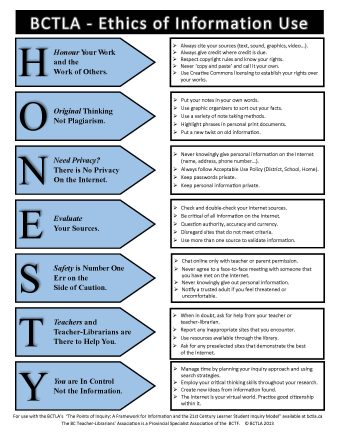Plagiarism is copying someone else’s information and claiming it as your own. To avoid plagiarism you must give written credit for sources of information you use for your work. Find out more below and in this video.
When you use any of the types of information listed below you must give credit to the original source of the information with a citation:
- text
- graphics
- works of art
- music
- cartoons
- excerpts
- quotations etc.
If you fail to cite the sources you use you may have to repeat the assignment. Your teacher(s) and/or the school administration may also decide on other disciplinary action. All use of generative artificial intelligence (AI) tools and all content you produce using these tools must be cited as well.
Check out this guide for more help.

Find out more at:

Creative Commons Images, Sounds etc
Here’s a short guide to citing information shared online with a Creative Commons license. This article and infographic provide a more detailed guide to how (and why) to give credit for images you would like to use. Use the following websites to find copyright free images:
When you use Creative Commons images, sounds, videos or any other content it is important that you give credit to the person who created that content. Include:
- Title of image
- Creator name
- Source of the image (usually in the form of a URL to image source page)
- Any copyright information included with image (such as a watermark)
- CC licence information (including link back to CC documentation page if possible)
View this guide for more detailed guidance on how to give appropriate credit.
Other copyright free image sources:
United States Government Sources:
Clip Art for Students and Educators:
Know Your Rights…and Copyrights
The Internet is more than simply a place to find information. It is a place to be creative and express yourself.
When we create, we use things we find around us. On the Internet, you will find words, pictures, music, and videos. Someone or some group of people made each of these. It’s fun to combine what other people have made with our own creations to express new ideas. People do it everyday. It’s how we communicate.
A colleague of mine, Mr. Richey, originally wrote a blog post about this and I have borrowed a lot of his ideas with his permission to put this webpage together. We both use information, pictures, and videos from other websites to help us express our ideas. But not everything on the Internet is there for the taking because not everyone wants to share or understands why they might want to or how to.
Mr. Richey says: “It is as important to respect each other on the Internet as it is in the “real world”. Just as I wouldn’t steal from someone in my neighborhood, I shouldn’t take what’s not mine on the Internet without permission. When I create this blog, I try to use only things others are willing to share. That way I respect the right of others.”
How do you know what you can use without abusing the rights of others? Check out Creative Commons. It is an excellent place to search for information, images, sounds, or videos you are free to use in your own creations. It’s a lot like searching Google, only everything you find can be shared.

